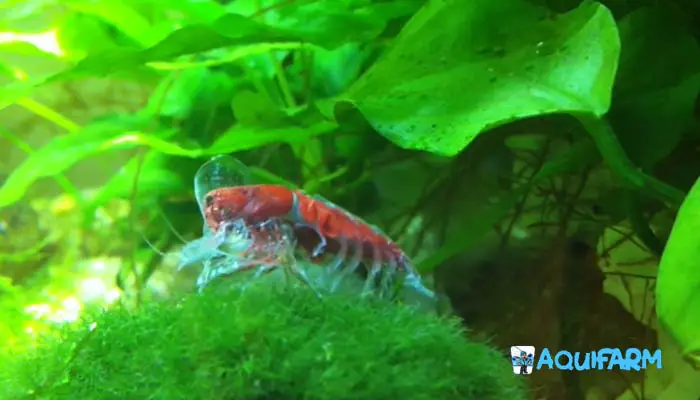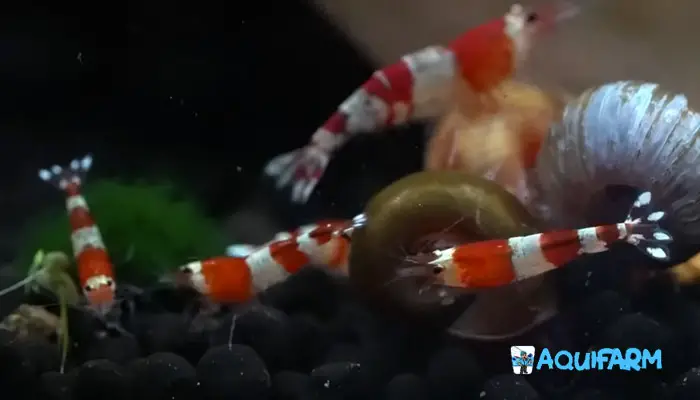White Stripe On Cherry Shrimp -Reason And Solution
If you keep a pair of cherry shrimp in your aquarium, they’ll add color, movement, and biodiversity without bothering tankmates. Cherry shrimp are peaceful and easy to keep with other small aquatic animals when the water is stable.
Their constant foraging and quick, twitchy movements fascinate both kids and adults.
But in home aquariums, shrimp can be affected by several issues. If you suddenly notice an unusual white stripe or whitening on a shrimp, don’t panic—identify the cause and correct it.
First, understand what conditions create white stripes or whitening on cherry shrimp. The most common are water quality imbalance, lighting/photoperiod stress, the molting stage (including the “white ring of death”), poor environmental conditions, and disease/parasites.
Now let’s break down each problem and the most effective, shrimp-safe solutions.
5 Reasons for White Stripe on Cherry Shrimp + Solution
1. Water Imbalance
Water quality is the #1 health driver for Neocaridina davidi (cherry shrimp). Ammonia or nitrite above 0, large pH swings, and high dissolved metals (especially copper) stress shrimp and can cause pallor/whitening.
Cherry shrimp are especially sensitive to copper from tap water, medications, and some plant fertilizers. They absorb it readily; toxicity leads to lethargy, failed molts, and death—not “more oxygen.” Whitening is a stress sign, not extra oxygen.
Instability (irregular top-ups/changes) also causes temperature and pH swings. Excess ammonia, nitrite, or high nitrate can all contribute to a pale band or overall whitening.
Control Measure
Prioritize stable, shrimp-safe water:
Targets: Ammonia 0 ppm, Nitrite 0 ppm, Nitrate < 20 ppm; pH 6.5–7.5; GH 6–8 dGH; KH 2–4 dKH; TDS ~150–250 ppm; Temp 24–26 °C (75–79 °F).
Avoid copper: use dechlorinator that binds heavy metals or run activated carbon/Poly-Filter. Be cautious with medications and plant foods containing copper.
Maintenance: small, regular changes (10–20% weekly), gentle filter flow, pre-condition new water to the same temp/TDS. A sponge pre-filter protects shrimplets.
Here are some recommended kits to monitor quality:
- API FRESHWATER MASTER TEST KIT
- SJ WAVE 7 in 1 Aquarium Test
2. Lighting Problem
Cherry shrimp don’t need strong light; 6–8 hours of moderate light is plenty. Excessive intensity or long photoperiods stress shrimp and can make pale bands more visible, especially if there’s no shade.
They feel safest with both lit and shaded zones created by floating plants and hardscape. A fully flooded, bright tank with no cover can raise stress hormones and suppress molting.
Control Measure
Run 6–8 hours/day on a timer. Provide shade with floaters (frogbit, red root floater) and plants like Java fern/moss. Place the tank where it receives indirect daylight, or use dimmable LEDs. Avoid on/off spikes—ramp up/down if possible.
3. Molting Stage

Every few weeks, shrimp shed their exoskeleton. Near a molt, color can look pale—normal. The risky scenario is the “white ring of death”: a bright horizontal white band around the body where the carapace splits. That’s a failed or incomplete molt and is life-threatening.
Failed molts are usually from low minerals (calcium/magnesium), big parameter swings, or stress.
Control Measure
Keep GH/KH within range and stable. Offer a calcium source (cuttlebone, mineral rocks, quality shrimp salts if you use RO/DI). Avoid large daily water changes during active molting—do small, gentle ones. Provide hides so freshly molted shrimp can harden up safely.
4. Diseases
Shrimp can be affected by bacteria, fungi, and parasites. Whitening/stripes can appear with each, but details differ:
Parasites commonly seen in shrimp tanks: Scutariella japonica (small white leech-like worms on the head/gills), Vorticella (white cottony tufts), and Ellobiopsidae (green/whitish spore masses on appendages). These can present as pale/white streaks or spots and irritate gills/legs.
Muscular necrosis: the tail/back muscle turns white/opaque from the rear forward—often linked to poor water quality, low oxygen, or big parameter swings.
Bacterial issues: true systemic infections are harder to confirm in home tanks and often show as lethargy, pinkish flesh, limb loss, or rapid deaths. Prevention (clean, stable water) is more reliable than medicating in display tanks.
Treatment Guide
Start with quarantine: move affected shrimp to a separate, cycled container with identical parameters. Support with pristine water and aeration.
For parasites: a brief, shrimp-safe salt dip (aquarium salt) can help with Scutariella/Vorticella—use 1 tbsp/gal (≈ 3.8 L) for 30–60 seconds while monitoring closely, then return to clean tank water. Commercial shrimp-safe treatments (e.g., betel-nut based products) or vet-guided fenbendazole are options; research dosage carefully.
For fungal-looking tufts: many “fungus” cases on shrimp are protozoans like Vorticella. Salt dips and improved water quality usually resolve them. Isolate heavily affected individuals.
For suspected bacterial issues: prioritize water quality, oxygenation, and low stress. Broad treatments in the display can harm biofiltration and shrimp—seek an aquatic vet for antibiotic guidance rather than dosing blindly.
Avoid hydrogen peroxide dosing in shrimp display tanks—H2O2 can injure shrimp and beneficial bacteria. If spot-treating algae elsewhere, keep peroxide away from shrimp systems.
Nutrition: offer mineral-rich foods (shrimp pellets, blanched spinach/kale, quality algae wafers) a few times per week; remove leftovers to keep ammonia at 0.
5. Stressful Aquatic Environment

Shrimp need a calm, stable environment. Poor oxygenation, overfeeding, lack of hides, aggressive tankmates, or chemical residues (soaps, cleaners, aerosols) increase stress and can lead to whitening and disease.
Tank size: 10–15 gallons is excellent for a colony; many keepers succeed in 5+ gallons with strict maintenance. Use a gentle sponge filter and keep flow moderate.
Scape: provide mosses (Java moss), epiphytes (Java fern), botanicals, and caves. Floating plants add shade and biofilm—the shrimp’s favorite snack.
Parameters: pH 6.5–7.5; 25–27 °C; GH/KH/TDS as above; oxygenation via surface ripple. Avoid detergents when cleaning and do 10–20% water changes weekly.
Frequently Asked Questions (FAQs)
What parasite attacks cherry shrimp?
Common parasites in shrimp tanks include Scutariella japonica (small white worms on the head/gills), Vorticella (white, cottony tufts), Ellobiopsidae (greenish/whitish masses on legs/antennae), and occasionally leeches or dragonfly nymphs in outdoor systems.
How do you get rid of fungus on shrimp?
Many cases that look like fungus are protozoans such as Vorticella. Use a short, watched salt dip (1 tbsp/gal for 30–60 sec) and improve water quality/oxygenation. Isolate affected shrimp. For persistent cases, consider a shrimp-safe treatment or consult an aquatic vet.
Conclusion
White stripes on cherry shrimp can stem from several causes. Identify whether it’s a harmless pre-molt pallor or a true problem (parasites, failed molt, poor water quality), then correct the root cause.
This guidance also applies to other Neocaridina color morphs: Yellow, Blue Dream, Black Rose, Snowball, Blue Pearl, Green Jade, and Blue Velvet. Keep parameters stable, avoid copper, provide minerals for molting, and maintain gentle, regular husbandry to keep your colony thriving.
- Honey Gourami Clamped Fins – Expert Guide To Diagnosis, Treatment, And - December 14, 2025
- Gourami Upside Down – Decoding Behavior & Ensuring A Thriving, Healthy - December 14, 2025
- Gourami Swimming Vertically – Deciphering Behavior & Ensuring Health - December 14, 2025
